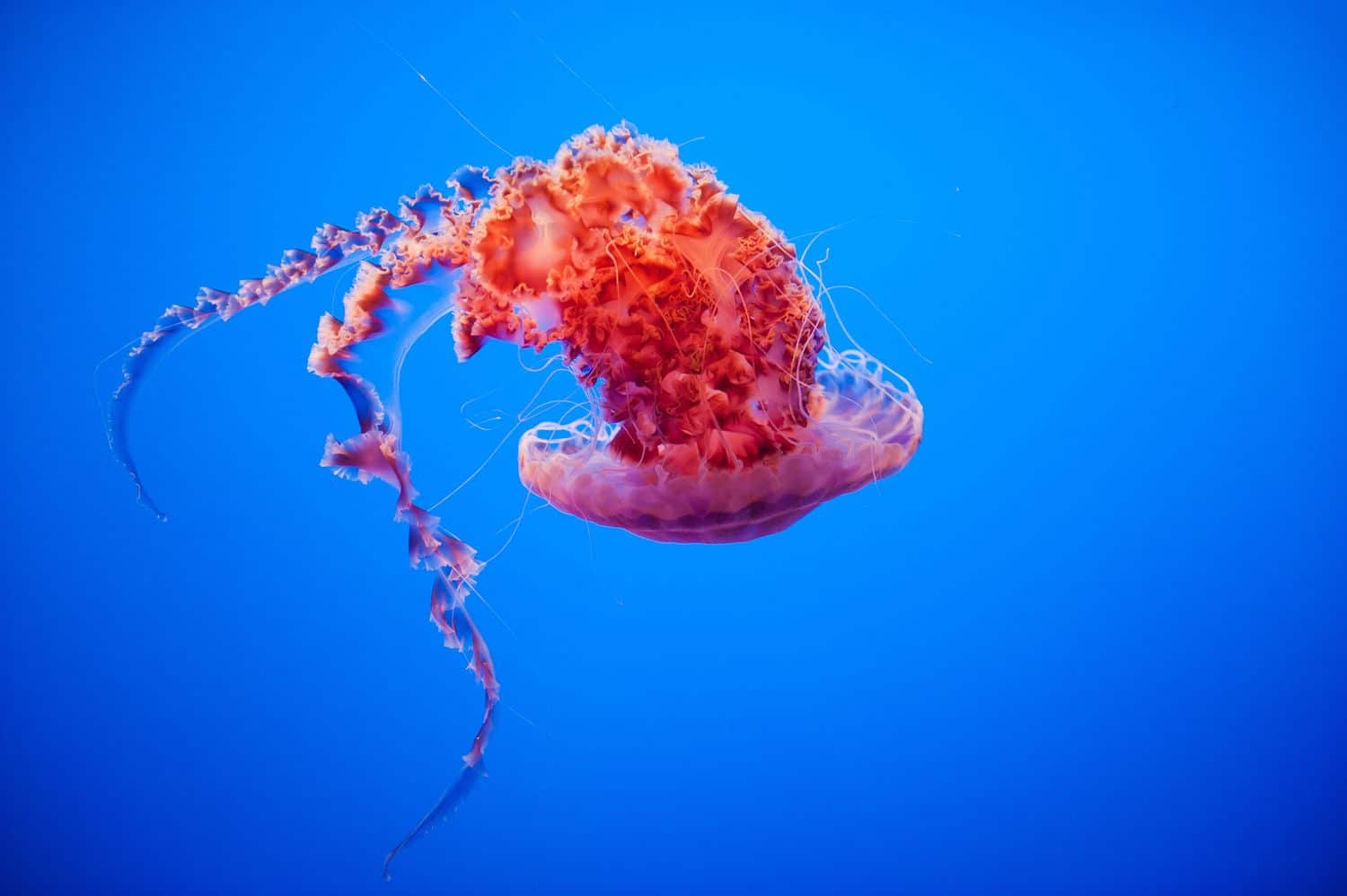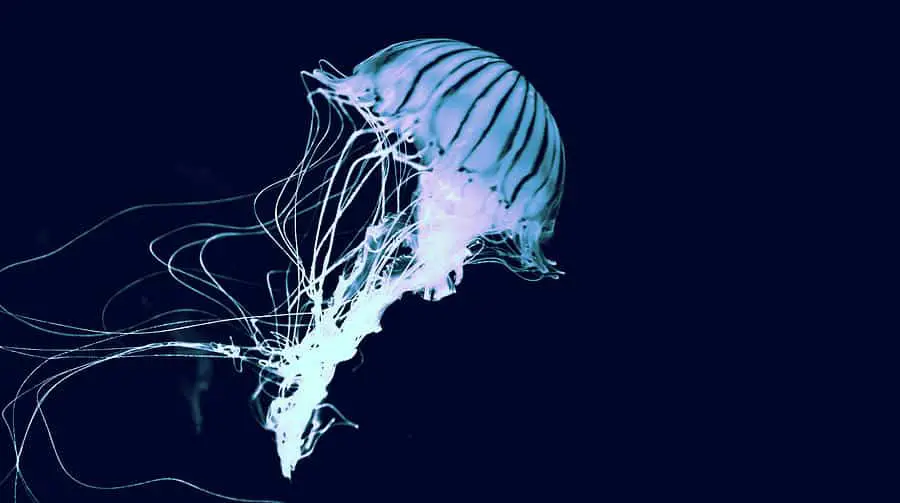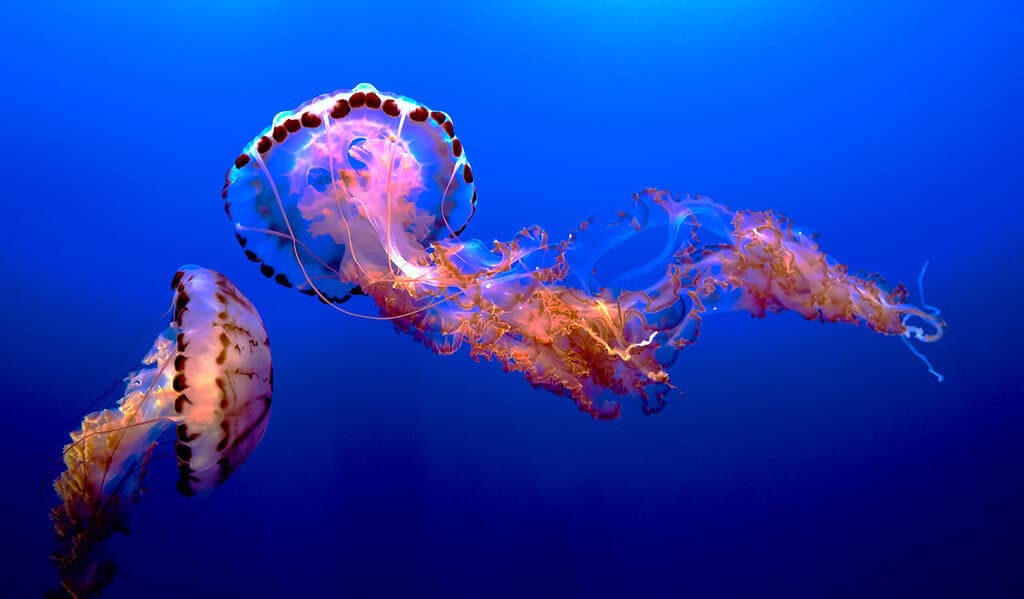Do Jellyfish Have Hearts

Introduction
Do Jellyfish Have Hearts: Jellyfish, with their graceful, pulsating movements and translucent bodies, have long captured the imagination of marine enthusiasts and scientists alike. These ancient creatures, known for their simplicity and otherworldly beauty, inhabit oceans across the globe, from the sunlit surface waters to the mysterious depths of the abyss.
The concept of a heart, a vital organ responsible for pumping blood or a similar circulatory fluid, is well-understood in vertebrate animals, including humans. In these creatures, a central heart is essential for distributing nutrients, oxygen, and other vital substances throughout the body. However, the invertebrate world, to which jellyfish belong, exhibits a staggering diversity of circulatory systems, or the lack thereof.
This inquiry into the presence or absence of a heart in jellyfish holds both scientific and ecological significance. Understanding the circulatory systems of these gelatinous organisms can shed light on their physiological adaptations and provide insights into their ecological roles in marine ecosystems. It may contribute to our broader understanding of the evolution of life on Earth, as jellyfish represent a lineage that predates many other complex organisms.
We delve into the enigmatic world of jellyfish biology, dissecting their anatomy, physiology, and behavior to unravel the mystery of whether these captivating creatures indeed possess hearts. Through a journey into the depths of marine biology, we aim to shed light on one of nature’s most intriguing questions.

How do jellyfish live without a heart?
Their skin is so thin that they can absorb oxygen right through it, so they don’t need lungs. They don’t have any blood so they don’t need a heart to pump it. And they respond to the changes in their environment around them using signals from a nerve net just below their epidermis — the outer layer of skin.
Jellyfish are primarily composed of a gelatinous mesoglea, which makes up the bulk of their body. This translucent substance is permeable, allowing for the diffusion of oxygen and nutrients directly into the jellyfish’s cells from the surrounding water. This diffusion-based system works efficiently for their relatively simple bodies, as they lack the complex organs and tissues found in vertebrates.
Additionally, jellyfish employ a rhythmic pulsating motion to aid in circulation. These pulsations help to move water in and out of their bodies, facilitating the exchange of gases and nutrients. Specialized cells in their epidermis, called cnidocytes, also play a role by generating water currents.
Jellyfish have evolved an elegant and effective means of survival in their aqueous environments. They have dispensed with the need for a conventional heart, instead relying on the combination of diffusion and their rhythmic movements to meet their metabolic requirements. This adaptation is a testament to the diversity of life forms on Earth and the myriad ways in which evolution has crafted solutions to the challenges of existence.
Do jellyfish have a heart or a brain?
Lacking brains, blood, or even hearts, jellyfish are pretty simple critters. They are composed of three layers: an outer layer, called the epidermis; a middle layer made of a thick, elastic, jelly-like substance called mesoglea; and an inner layer, called the gastrodermis.
The enigmatic world of jellyfish biology raises intriguing questions about the presence of a heart or a brain in these ethereal marine creatures. Unlike many animals that possess well-defined central organs, the anatomy of jellyfish is significantly simpler.
Firstly, the notion of a brain, as we understand it in more complex organisms, is absent in jellyfish. Instead, they have a decentralized nervous system, consisting of a loose network of nerve cells or neurons spread throughout their epidermis. This rudimentary nervous system allows them to respond to stimuli in their environment, such as light and touch, but it lacks the complexity associated with higher-order cognition.
As for a heart, jellyfish do not have a traditional heart like vertebrates. Their circulatory system relies heavily on the diffusion of gases and nutrients through their gelatinous bodies. While some jellyfish exhibit pulsating motions to help with circulation, this process is not heart-driven and does not involve a centralized, muscular organ like in animals with true hearts.
Jellyfish challenge our conventional understanding of complex organ systems. They lack a traditional brain and heart but possess adaptations that allow them to thrive in their aquatic habitats. This intriguing simplicity in their biology showcases the remarkable diversity of life on Earth and reminds us that there are still mysteries to be unraveled in the natural world.
How do jellyfish live without brain or heart?
Jellyfish have no such central place; in fact, they have two nervous systems. A large nerve net controls swimming and a small nerve net controls all other behaviors, including feeding and spasm response (briefly curling into a ball).
The fascinating existence of jellyfish without a conventional brain or heart presents a captivating puzzle in the realm of marine biology. These creatures defy the traditional norms of complex organ systems, yet they flourish in oceans worldwide through ingenious adaptations.
Jellyfish’s absence of a centralized brain does not hinder their survival. Instead, they rely on a decentralized network of nerve cells, distributed across their epidermis, to process sensory information and initiate basic motor responses. This decentralized neural arrangement is sufficient for them to navigate their surroundings, capture prey, and avoid predators.
Jellyfish’s circulatory system operates without a traditional heart. Their bodies, composed mainly of gelatinous mesoglea, facilitate the diffusion of oxygen, nutrients, and metabolic waste products through their cells. Some species employ rhythmic pulsations to aid in circulation, drawing in water and facilitating these essential exchanges.
These unique adaptations enable jellyfish to thrive despite the absence of complex central organs. They have evolved to be perfectly suited to their niche in the marine ecosystem, serving as both mesmerizing inhabitants of the ocean and subjects of scientific curiosity. The study of jellyfish reminds us that life on Earth can take diverse and extraordinary forms, challenging our understanding of what is essential for survival and adaptation in the natural world.
Are jellyfish considered alive?
Jellyfish belong to a group called Cnidaria, which also includes sea anemones and corals. As animals, they are subject to the cycle of life and death – though one species is known to bend the rules.
The question of whether jellyfish are considered alive may seem paradoxical, given their mesmerizing, pulsating movements in the world’s oceans. However, it touches upon the complex and often debated concept of life itself.
Jellyfish are indeed classified as living organisms within the biological kingdom of Animalia. They exhibit essential characteristics of life, such as growth, reproduction, and response to stimuli. They are composed of cells, can reproduce to create new generations, and have a rudimentary nervous system that enables them to react to their environment, albeit in a simple manner.
However, the concept of life exists on a continuum, with complex organisms like humans at one end and simpler life forms like jellyfish at the other. Jellyfish lack many of the features commonly associated with higher-order animals, such as a centralized brain, intricate organ systems, and the capacity for conscious awareness.
So, while jellyfish are undoubtedly living organisms by scientific classification, their simplicity raises philosophical questions about the nature of life. They remind us that life manifests in diverse and often surprising ways, challenging our understanding of what it means to be alive and prompting contemplation about the fundamental essence of existence in the natural world.
Do jellyfish feel pain?
Can jellyfish feel pain? Jellyfish don’t feel pain in the same way that humans would. They do not possess a brain, heart, bones or a respiratory system. They are 95% water and contain only a basic network of neurons that allow them to sense their environment.
Unlike animals with more complex nervous systems, such as mammals or birds, jellyfish possess a decentralized and rudimentary nervous system consisting of a loose network of nerve cells. This basic neural arrangement allows them to respond to environmental stimuli, but it lacks the complexity associated with experiencing pain in the way more advanced animals might.
Many scientists argue that the ability to feel pain as experienced by humans and some other animals requires a higher level of consciousness and neural sophistication that is likely beyond the capacity of jellyfish. They are thought to lack the brain structures and neural pathways necessary for processing pain signals in the way that vertebrates do.
However, the question remains contentious, and some researchers advocate for caution and ethical considerations when handling and studying jellyfish. While it is unlikely that jellyfish experience pain in the same way as humans or more complex animals, the possibility of some form of nociception or a rudimentary response to harmful stimuli raises important ethical questions about their treatment and conservation.
The scientific consensus leans towards jellyfish not experiencing pain in the same manner as animals with more advanced nervous systems, but the topic continues to be a subject of debate and ethical contemplation in the field of marine biology and animal welfare.
How do jellyfish transport nutrients and oxygen throughout their bodies without a heart?
Jellyfish, mesmerizing creatures of the sea, possess a unique and efficient method of nutrient and oxygen transport, despite lacking a traditional circulatory system with a heart. Instead, they rely on a simple yet ingenious network of thin, branching canals known as the gastrodermis. This intricate system permeates their gelatinous bodies, forming a delicate web-like structure.
Seawater, rich in dissolved oxygen and nutrients, permeates the surface of the jellyfish’s bell through specialized cells. These cells, called gastrodermal cells, selectively extract essential substances from the surrounding environment. Through a process known as diffusion, oxygen molecules are absorbed, while vital nutrients like plankton and small fish are digested within the gastrodermal cells.
As the seawater’s nutrients and oxygen diffuse into the gastrodermis, they are swiftly transported to all regions of the jellyfish’s body. This distribution is facilitated by the jellyfish’s pulsating bell, a rhythmic contraction and expansion that propels water through the gastrovascular system. This pulsation not only aids in nutrient dispersal but also enables locomotion, propelling the jellyfish gracefully through the ocean’s depths.
In this remarkable dance of nature, jellyfish exemplify the beauty of adaptation, showcasing that even without a heart, life’s essential sustenance can be efficiently transported, allowing these ethereal creatures to thrive in the boundless expanse of the sea.
What is the role of the gastrovascular cavity in jellyfish?
The gastrovascular cavity is the lifeblood of a jellyfish, serving as its central hub for both digestion and nutrient distribution. Unlike creatures with a dedicated circulatory system, jellyfish, lacking a conventional digestive tract, have ingeniously evolved this multifunctional chamber. Situated within their gelatinous bodies, it resembles a delicate, branching network of canals.
Upon capturing prey with their tentacles, jellyfish employ specialized cells within the gastrodermis to release enzymes into the cavity. These enzymes swiftly break down the captured food into simpler, absorbable nutrients. This process of extracellular digestion allows the jellyfish to extract essential elements like proteins, carbohydrates, and fats from their prey.
Moreover, the gastrovascular cavity acts as a conduit for oxygen uptake. Thin-walled cells lining the cavity facilitate the exchange of oxygen and carbon dioxide with the surrounding seawater. Through a passive process of diffusion, oxygen molecules enter the jellyfish’s body while metabolic waste gases are expelled.
Simultaneously, the pulsating motion of the jellyfish’s bell propels seawater through the gastrovascular system, ensuring a continuous flow of nutrients and oxygen. This rhythmic contraction not only aids in distribution but also enables locomotion. In essence, the gastrovascular cavity is the epicenter of a jellyfish’s existence, orchestrating the vital processes of digestion, respiration, and locomotion in perfect harmony.
How do jellyfish maintain fluid balance and regulate buoyancy without a heart?
Jellyfish, despite their lack of a traditional circulatory system, exhibit a remarkable ability to maintain fluid balance and regulate buoyancy in their aquatic environment. This feat is orchestrated by a dynamic interplay of osmoregulation and specialized structures within their gelatinous bodies.
Osmoregulation, a pivotal process for marine organisms, is particularly critical for jellyfish. They possess specialized cells, known as epitheliomuscular cells, which line their outer surface. These cells actively regulate the concentration of salts and other solutes within the jellyfish’s body. By selectively pumping ions in and out of their cells, jellyfish can adjust their internal osmolarity to match that of the surrounding seawater.
Additionally, buoyancy is managed through a specialized structure called the mesoglea, a thick, jelly-like substance that comprises a significant portion of the jellyfish’s body. By controlling the water content within the mesoglea, jellyfish can alter their buoyancy. By contracting and expanding their bell, they adjust the pressure within the mesoglea, allowing them to ascend or descend within the water column.
Through these ingenious adaptations, jellyfish masterfully navigate their watery realm, effortlessly maintaining their position and fluid balance without the aid of a heart, showcasing the elegant efficiency of nature’s design.

Conclusion
We have embarked on a journey through the captivating world of marine biology. Throughout this exploration, we have uncovered fascinating insights into the intricate physiology and enigmatic nature of these ancient creatures.
While the question of whether jellyfish possess hearts remains unanswered definitively, our investigation has revealed that they employ alternative mechanisms to circulate vital nutrients and oxygen throughout their bodies. These mechanisms are notably distinct from the centralized heart system seen in vertebrates. Instead, jellyfish rely on a combination of diffusion, pulsating movements, and specialized cells to maintain their metabolic needs.
Our journey has underscored the importance of studying even the most seemingly simple organisms like jellyfish. These creatures, often overlooked due to their lack of complex organs, play vital roles in marine ecosystems and contribute to our understanding of evolutionary biology.
While we have not found a conventional heart in jellyfish, our exploration has deepened our appreciation for the wonders of the natural world. It reminds us that there are still mysteries waiting to be unraveled beneath the ocean’s surface, and in the case of jellyfish, the absence of a heart is a testament to the diversity and adaptability of life on our planet.



